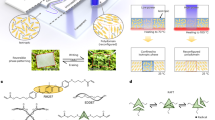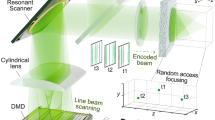Abstract
Metamaterials provide an unprecedented ability to manipulate electromagnetic waves and are an enabling technology for new devices ranging from flat lenses that focus light beyond the diffraction limit to coatings capable of cloaking an object. Nevertheless, narrow bandwidths and high intrinsic losses arising from the resonant properties of metamaterials have raised doubts about their usefulness. New design approaches seek to turn the perceived disadvantages of dispersion into assets that enhance a device’s performance. Here we employ dispersion engineering of metamaterial properties to enable specific device performance over usable bandwidths. In particular, we design metamaterials that considerably improve conventional horn antennas over greater than an octave bandwidth with negligible loss and advance the state of the art in the process. Fabrication and measurement of a metahorn confirm its broadband, low-loss performance. This example illustrates the power of clever implementation combined with dispersion engineering to bring metamaterials into their full potential for revolutionizing practical devices.
This is a preview of subscription content, access via your institution
Access options
Subscribe to this journal
Receive 12 print issues and online access
$259.00 per year
only $21.58 per issue
Buy this article
- Purchase on Springer Link
- Instant access to full article PDF
Prices may be subject to local taxes which are calculated during checkout





Similar content being viewed by others
Change history
03 February 2011
In the version of this Article originally published online, the values on the y-axis of Fig. 2d were incorrectly aligned. This error has now been corrected in all versions of the text.
References
Pendry, J. B. Negative refraction makes a perfect lens. Phys. Rev. Lett. 85, 3966–3969 (2000).
Veselago, V. G. The electrodynamics of substances with simultaneously negative values of ɛ and μ. Sov. Phys. Usp. 10, 509–514 (1968).
Klein, M. W., Enkrich, C., Wegener, M., Soukoulis, C. M. & Linden, S. Single-slit split-ring resonators at optical frequencies: Limits of size scaling. Opt. Lett. 31, 1259–1261 (2006).
Shalaev, V. M. Optical negative-index metamaterials. Nature Photon. 1, 41–48 (2007).
Bossard, J. A., Yun, S., Werner, D. H. & Mayer, T. S. Synthesizing low loss negative index metamaterial stacks for the mid-infrared using genetic algorithms. Opt. Express 17, 14771–14779 (2009).
Schurig, D. et al. Metamaterial electromagnetic cloak at microwave frequencies. Science 314, 977–980 (2006).
Cai, W., Chettiar, U. K., Kildishev, A. V. & Shalaev, V. M. Optical cloaking with metamaterials. Nature Photon. 1, 224–227 (2007).
Kwon, D-H. & Werner, D. H. Transformation electromagnetics: An overview of the theory and its application. IEEE Antennas Propag. Mag. 52, 24–26 (2010).
Kwon, D-H. & Werner, D. H. Transformation optical designs for wave collimators, flat lenses, and right-angle bends. New J. Phys. 10, 115023/1-13 (2008).
Narimanov, E. E. & Kildishev, A. V. Optical black hole: Broadband omnidirectional light absorber. Appl. Phys. Lett. 95, 041106 (2009).
Eleftheriades, G. V. & Balmain, K. G. Negative-Refraction Metamaterials: Fundamental Principles and Applications (John Wiley and IEEE Press, 2005).
Ziolkowski, R. W. & Peng, J. Metamaterial-based dispersion engineering to achieve high fidelity output pulses from a log-periodic dipole array. IEEE Trans. Antennas Propag. 56, 3619–3629 (2008).
Caloz, C., Sanada, A. & Itoh, T. A novel composite right/left-handed coupled-line directional coupler with arbitrary coupling level and broad bandwidth. IEEE Trans. Microw. Theory Tech. 52, 980–992 (2004).
Caloz, C. & Itoh, T. Electromagnetic Metamaterials, Transmission Line Theory and Microwave Applications (Wiley and IEEE Press, 2006).
Zouhdi, S., Sihvola, A. & Vinogradov, A. P. Metamaterials and Plasmonics: Fundamentals, Modelling, Applications (Springer Science+BusinessMedia, 2009).
Gupta, S. & Caloz, C. Analog signal processing in transmission line metamaterial structures. Radioengineering 18, 155–167 (2009).
Zheludev, N. I. The road ahead for metamaterials. Science 328, 582–583 (2010).
Liu, N. et al. Plasmonic analogue of electromagnetically induced transparency at the Drude damping limit. Nature Mater. 8, 758–762 (2009).
Balanis, C. A. Antenna Theory: Analysis and Design (John Wiley, 2005).
Lier, E. & Kildal, P. S. Soft and hard horn antennas. IEEE Trans. Antennas Propagat. 36, 1152–1157 (1988).
Lier, E. A dielectric hybrid mode antenna feed: A simple alternative to the corrugated horn. IEEE Trans. Antennas Propagat. 34, 21–29 (1986).
Clarricoats, P. J. D. & Oliver, A. D. Corrugated Horns for Microwave Antennas (Peter Peregrinus, IEE, 1984).
Peace, G. M. & Swartz, E. E. Amplitude compensated horn antenna. Microwave J. 7, 66–68 (1964).
Lier, E. & Shaw, R. K. Design and simulation of metamaterial-based hybrid-mode horn antennas. Electron. Lett. 44, 1444–1445 (2008).
Lier, E. & Katz, A. US patent 7,629,937 (2009).
Rotman, W. Plasma simulation by artificial dielectrics and parallel-plate media. IRE Trans. Antennas Propag. 10, 82–95 (1962).
Minnett, H. C. & Thomas, B. MacA. A method of synthesizing radiation patterns with axial symmetry. IEEE Trans. Antennas Propag. 14, 654–656 (1966).
Munk, B. A. Frequency Selective Surfaces: Theory and Design (John Wiley, 2000).
Haupt, R. L. & Werner, D. H. Genetic Algorithms in Electromagnetics (John Wiley, 2007).
Kildal, P. S. Artificially soft and hard surfaces in electromagnetics. IEEE Trans. Antennas Propag. 38, 1537–1544 (1990).
Liu, K., Balanis, C. A., Birtcher, C. R. & Barber, G. C. Analysis of pyramidal horn antennas using moment methods. IEEE Trans. Antennas Propag. 41, 1379–1389 (1993).
Sievenpiper, D., Zhang, L., Broas, R. F. J., Alexópolous, N. G. & Yablonovitch, E. High-impedance electromagnetic surfaces with a forbidden frequency band. IEEE Trans. Microwave Theory Tech. 47, 2059–2074 (1999).
Acknowledgements
The work presented in this paper was funded by Lockheed Martin under the University Research Initiative (URI) program.
Author information
Authors and Affiliations
Contributions
E.L. conceived the soft-metahorn applications and concept for implementation and made measurements. D.H.W. supervised the project and contributed to the metamaterial-liner design concepts. C.P.S. built the metamaterial liner and carried out simulations of the metahorn. Q.W. designed the metamaterial liners. J.A.B. analysed data and authored most of the paper.
Corresponding authors
Ethics declarations
Competing interests
The authors declare no competing financial interests.
Supplementary information
Supplementary Information
Supplementary Information (PDF 751 kb)
Rights and permissions
About this article
Cite this article
Lier, E., Werner, D., Scarborough, C. et al. An octave-bandwidth negligible-loss radiofrequency metamaterial. Nature Mater 10, 216–222 (2011). https://doi.org/10.1038/nmat2950
Received:
Accepted:
Published:
Issue Date:
DOI: https://doi.org/10.1038/nmat2950
This article is cited by
-
Pulse-driven self-reconfigurable meta-antennas
Nature Communications (2023)
-
High-isolation antenna array using SIW and realized with a graphene layer for sub-terahertz wireless applications
Scientific Reports (2021)
-
A metamaterial-enabled design enhancing decades-old short backfire antenna technology for space applications
Nature Communications (2019)
-
Mode coupling in periodic surface lattice and metamaterial structures for mm-wave and THz applications
SN Applied Sciences (2019)
-
A microfabricated low-profile wideband antenna array for terahertz communications
Scientific Reports (2017)



